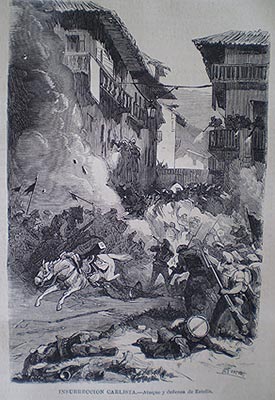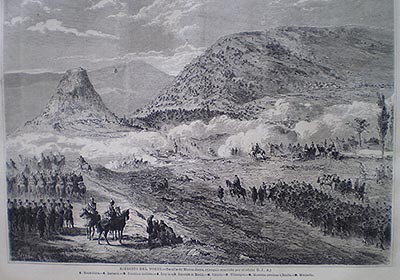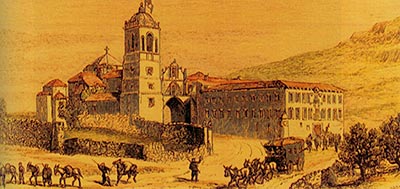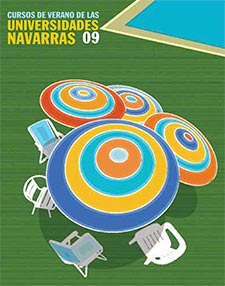BRINGING THE HERITAGE CLOSER. ESTELLA, ART AND THE ROAD
28 August 2009
Images of a conflict. Estella and the last Carlist War
D. Ignacio J. Urricelqui Pacho. Chair of Navarrese Heritage and Art.
The lecture offered a vision of the development of the last Carlist war in Tierra Estella using photographs and images of the illustrated press published during the events in Spanish and foreign magazines, mainly French, American and English. In this way, it was possible to verify how the facts of arms and the social reality of the moment were disseminated and, in this way, known in different areas, allowing the public opinion to form an image of the facts, although sometimes it was manipulated by the sides and presented a clear propagandistic vocation.
The starting point was the consideration of Carlism as a counterrevolutionary movement developed throughout the 19th century and which, necessarily, must be related to the liberal revolution for its correct understanding. In this way, far from Manichean positions, the image offered of the conflict by both sides often suffered from the same excesses and defects in terms of offering a plausible image of what happened.
Although photography was used, the most important field employee in lecture was the graphic illustration that appeared in Spanish magazines such as La Ilustración Española y Americana, or foreign magazines such as The Graphic, Le Monde Illustré, Harper's Weekly or The Illustrated London News, among others. In addition, special attention was paid to the role of "war correspondents", in particular the Spanish José Luis Pellicer and the Navarrese Nemesio Lagarde.
The lecture presented the role of Estella as a Carlist Court and center of operations, particularly in its surroundings, with relevant events such as the battles of Montejurra (1873), Abárzuza (1874) or Lácar (1875). Likewise, special attention was paid to the role of the Hospital de la Caridad installed in the monastery of Irache, which played a role core topic in the sanitary actions of war.

"Defense of Estella," La Ilustración Española y Americana, August 8, 1873.

"Battle of Monte-Jurra," La Ilustración Española y Americana, November 24, 1873.

"View of the Charity Hospital installed in the monastery of Irache," The Graphic, December 12, 1874.
PROGRAM
TUESDAY, AUGUST 25
The splendor of Estella in the Renaissance. Art and Artists
Ms. María Concepción García Gainza. Chair of Navarrese Heritage and Art.
Image of God, image of man: the façade of San Miguel de Estella
Mr. Javier Martínez de Aguirre Aldaz. Complutense University of Madrid
San Pedro de la Rúa: styles and interstyles in a medieval building.
D. Carlos J. Martínez Álava. I.E.S. "Pedro de Ursua" of Pamplona
WEDNESDAY, AUGUST 26TH
Following in the footsteps of the Gothic in Estella: Santo Sepulcro and Santo Domingo
Ms. Santiaga Hidalgo Sánchez. Chair of Navarrese Heritage and Art.
Estella's movable heritage
Ms. Mercedes Jover Hernando. Chair of Navarrese Heritage and Art.
A city born for the Camino. visit guided tour of the city of Estella
D. Román Felones Morrás. Full Professor of Geography and History of the I.E.S. Tierra Estella.
THURSDAY, AUGUST 27TH
Architecture and Humanism in Estella in the 16th century.
Mrs. María Josefa Tarifa Castilla. Chair of Navarrese Heritage and Art.
Traces of the Baroque in Estella
Ms. Pilar Andueza Unanua. Chair of Navarrese Art and Heritage.
The sumptuary arts in Estella: from the Age average to the 19th century.
D. Ignacio Miguéliz Valcarlos. Chair of Navarrese Heritage and Art.
FRIDAY, AUGUST 28TH
Images of a conflict. Estella and the last Carlist War
D. Ignacio Jesús Urricelqui Pacho. Chair of Navarrese Heritage and Art.
reportIdentity and image of Estella in the plastic arts of the 19th and 20th centuries.
Mr. José Javier Azanza López. Chair of Navarrese Heritage and Art.
Museum and city. Gustavo de Maeztu and Estella
D. Gregorio Díaz Ereño. Director of the Jorge Oteiza Museum.
Closing

